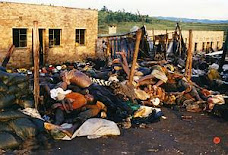African Affairs, 00/00, 1–2 doi: 10.1093/afraf/adaa014 © The Author(s) 2020. Published by Oxford University Press on behalf of Royal African Society. All rights reserved. For permissions, please e-mail: journals. permissions@oup.com
BOOK REVIEW
INTENT TO DECEIVE: DENYING THE GENOCIDE OF THE TUTSI, by Linda Melvern. London-New York: Verso, 2020. 264 pp. £16.99 (hardback). ISBN 978 1 78873 328 1
Rwanda is a contentious and polarised subject. While recognising the country's economic achievements, much of the scholarship is highly critical of its political governance. But there are also staunch defenders of the ruling Rwandan Patriotic Front (RPF), and journalist and author Linda Melvern is one of them. In 2017, she and eight others received the Igihango National Order of Outstanding Friendship medal from President Kagame 'in recognition of their exemplary service to the nation in various capacities'.
There are two major and obvious truths in this book: that a genocide was committed against the Rwandan Tutsi in 1994 and that some, including of course those who committed it, deny that this crime happened. This book was not necessary to tell these truths, because only a fringe opinion denies either. However, Melvern sees 'a pernicious campaign that exists to undermine the established facts', 'phoney science given credence', and 'contempt for factual evidence' (p. 1).What she claims are false readings are readings that differ from those that she and the RPF advocate. In reality, she shows that the past 30 years' history of Rwanda remains contested, including in academia, and that there is no generally accepted version of many events discussed in 'Intent to Deceive'.
When there are diverging positions on issues like the planning of the genocide, the number of victims, the perpetrators of the attack against President Habyarimana's plane that sparked the resumption of the civil war and the killings, the RPF's human rights record, and victors' justice at the International Criminal Tribunal for Rwanda (ICTR), each time Melvern attempts to prove the RPF's version and discredit opposing ones. She does so by being selective in the use of sources, the quality of which are often poor. Sources that are relevant but do not suit the narrative are ignored. A number of important affirmations are not even sourced at all (e.g. the stockpiling of machetes, p. 34; a 'secret meeting' of the BBC trustees, p. 123).Melvern's bias is also conveyed in her wording: RPF abuse is 'alleged', 'claimed', or 'based on rumours', while those debunking these allegations 1 Downloaded from https://academic.oup.com/afraf/advance-article-abstract/doi/10.1093/afraf/adaa014/5850661 by Universiteit Antwerpen Bibliotheek user on 04 June 2020 2 BOOK REVIEWS 'are convinced' and base their view on 'a tide of overwhelmingly contrary evidence (p. 184)'.
This confirmation bias naturally has an impact on the presentation of facts, some of which are demonstrably false. Just a few examples may serve to illustrate this. Melvern writes that Belgian journalist Colette Braeckman was in Kigali on 6 April 1994 (p. 44), which allowed her to witness a crucial fact first-hand. However, Braeckman was in Brussels at the time. Contrary to Melvern's claim that the classifications of Hutu, Tutsi, and Twa during colonial days was based on the measuring of 'height, the length of the nose, the shape of the eyes and so on' (p. 67), it was done by self-identification. The interim government was not 'put together in the French embassy' (p. 86), but at the Rwandan Defence Ministry. Melvern mentions 'literally hundreds of pieces of available evidence demonstrating that a conspiracy to eliminate the Tutsi was in place' (p. 159). However, unfortunately there was not much of a paper trail, which is why the ICTR held that the conspiracy charge 'was not supported by sufficiently reliable evidence' in a judgment quoted by Melvern herself (p. 91). The 1978 constitution 'had institutionalised the quota system in society, whereby a certain percentage of Tutsi had places in higher education and state employment' (p. 187). This is indeed sometimes claimed in Kigali, but had Melvern consulted the constitution, she would have noticed that there was no explicit or implicit mention of quotas. The only reference to ethnicity was in a provision outlawing discrimination, among other things, on ethnic grounds.
In reality, Melvern's book is illustrative of the difficulties facing Rwanda studies. A conversation on facts and their interpretation becomes impossible when false accusations are levelled against participants, for instance, by branding them as genocide deniers, merely because they have a different reading of events. Throughout the book, several scholars and other writers, including the author of this review, are accused of denial, although they unambiguously acknowledge the historical fact that the Rwandan Tutsi have been the victims of genocide.
At the end of this critical review, useful contributions must also be mentioned. Indeed, the book is not only well written, but it offers interesting and at times novel insights into a number of events, in particular the way in which the UN Security Council treated the Rwanda situation, the tactics and policies developed by the genocidal interim government, and the functioning of the ICTR. But 'Intent to Deceive' must be read with great caution, and this book is unlikely to settle the many controversies surrounding the past three decades of Rwandan history.
University of Antwerp
Filip Reyntjens
filip.reyntjens@uantwerpen.be








No comments:
Post a Comment
Note: only a member of this blog may post a comment.